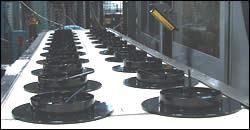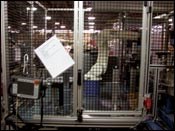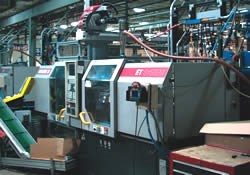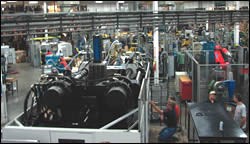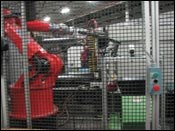Digital Manufacturing’s Role in Today’s Mold Shop
Mold manufacturers are seeing the benefits that low-volume digital manufacturing services can provide as a non-competitive alternative.
Digital manufacturing is finding a new home with mold manufacturers. With customers placing repeat orders that tend to be low volume and take time and resources away from in-production projects, it makes sense for moldmakers to look for fast, efficient alternatives to in-house production of those projects.
In the past, mold shops hesitantly outsourced those projects to competitors because other options were absent. Recently, mold manufacturers are seeing the benefits that low-volume digital manufacturing services can provide as a non-competitive alternative.
Before Digital Manufacturing
REO Plastics, Inc., a Maple Grove, MN-based company, has provided injec-
tion molding and manufacturing services for more than 40 years. According to Paul Levenson, tooling engineer at REO Plastics, “Service providers that offer digital manufacturing tend to use state-of-the-art technology and materials. We would have to buy a machine that starts to age. It would be difficult to keep up with the technology and overhead costs associated with purchasing that machine.”
For REO, the option to digitally manufacture models and parts for customers is a key to their success. Using fused deposition modeling® technology, REO can help its customers test form, fit and function during the research and development process of new products.
Traditional manufacturing processes require at least an eight- to 10-week leadtime. An organization will design the projects and send it to a molder/moldmaker, like REO, who will help them refine the design to obtain the best manufactured results. The shop then produces a mold to manufacture a sample, but the complexity of the design in creating the mold can add even more leadtime to the estimated eight to 10 weeks.
“There is a lot of labor involved from the toolmaker,” says John Adamski, tooling manager at REO Plastics. “It could take 300 to 400 hours. That’s nearly 70 percent of the time it takes to produce the mold.”
Prior to identifying digital manufacturing as an alternative to soft tooling, many molders/mold shops used urethane casting to create models. That process is slowly disappearing because the urethane molds wear out after a few uses, which means creating a new one if testing is still in progress. That can prove costly both from a materials and resources perspective.
If a fixture is needed and the design is simple, a 2-D sketch will suffice for aluminum tooling. For more complex geometries, where a 3-D design is necessary, engineers use 3-D CAD and digital manufacturing processes to capture all of the intricate dimensions of the design. For example, a fixture with arcs, curves and angles is a better fit for digital manufacturing.
Using Digital Manufacturing
The term digital manufacturing is starting to gain avid use in the industry; however, definitions vary. According to the Society of Manufacturing Engineers, “Direct digital manufacturing is the process of going directly from an electronic digital representation of a part to the final product via additive manufacturing.” Additive manufacturing, then, according to SME, “is the process of creating a physical object through the selective fusion, sintering or polymerization of a material.” Most industry references describe digital manufacturing as a part of product lifecycle management. We must, then, also discuss indirect digital manufacturing, which is a relatively new term used to identify the production of engineering aids, such as jigs and fixtures.
As previously mentioned, creating a mold is a labor-intensive project—constituting nearly 70 percent of the time it takes to produce the tool. Tool design, tool build, machining time, assembly and imminent scheduling conflicts make up the majority of the labor. The decision to use digital manufacturing is usually based on customer need.
Most engineers design a concept and send it to a molder/moldmaker while the design is still going through multiple iterations. With digital manufacturing, there are no cost penalties for changes throughout the design process. By using aluminum or steel tooling, the leadtime is two to 10 weeks just for design validation. In addition, there are added costs to using aluminum or nonferrous steel for pilot builds from wasted materials. With digital manufacturing processes, such as fused deposition modeling, only the materials needed for the build are used. There is no excess or waste, making it a more cost-effective and environmentally friendly process.
The availability of materials—similar to those required for end use—is a main concern for engineers during the testing and validation stage of design. Thermoplastic materials provide a range of testing criteria to suit some of the most rigorous testing methods. Due to its temperature resistance, range of components and flexibility, thermoplastics provide better usability at a lower cost, which allows molder/moldmakers, like REO, to offer a less expensive alternative to its customers over traditional tooling.
RP Justification
We live in a society of instant gratification and that crosses all industries and ways of life. Therefore, most organizations are designing a product to rapidly manufacture and put on the market. Rapid prototyping allows engineers to test form, fit and function of the product before mass production. However, when it takes 10 weeks to create a mold to mass produce that project, digital manufacturing is key to getting initial products to the market and test its acceptance before mass production takes place. When the cost to create a mold is in excess of $25,000, it makes perfect sense to digitally manufacture the product and determine its worth before making that kind of an investment.
Gaining market acceptance is conducted in a variety of ways. One of the most common is by using models to illustrate the look and feel of the finished product. In that instance, a rapid prototype is an ideal production source. “If you process a project as rapid prototyping, that’s that,” says Levenson. “Now, there are more opportunities to do production runs with better surface finishes. And we don’t need a prototyping shop in our facility.”
Many organizations are starting to realize the benefits of outsourcing low-volume manufacturing jobs. “We do it because companies that specialize in digital manufacturing and rapid prototyping services will always have the most current equipment,” says Adamski. “It’s more economical for REO to outsource that service instead of buying a machine. We achieve the benefits without the long-term investment.”
“It enhances our abilities,” adds Levenson, “It gives us a wider variety of options to offer our customers.”
A recent article in IndustryWeek reiterates that notion. According to the article, which quotes Ed Miller, CIMdata’s president, “Digital manufacturing technologies are typically implemented to … establish proof of concept, program and deploy machinery sooner and validate processes before their release to manufacturing.” The article goes on to cite a DELMIA-sponsored survey conducted by CIMdata that found “Digital manufacturing technology was helping organizations complete tasks that could not otherwise be accomplished.” The CIMdata research revealed that it is possible for organizations adopting digital manufacturing technology to experience a high rate of return—annual returns five to 10 times their annual investment.”
With data like that, the move to digital manufacturing will prove swift and sudden. It is imperative for organizations considering this service to take into account the capacity of their provider to manage multiple projects without the scheduling conflicts and time constraints experienced with traditional manufacturing processes.
Related Content
The Trifecta of Competitive Toolmaking
Process, technology and people form the foundations of the business philosophy in place at Eifel Mold & Engineering.
Read MoreThink Safety: Eliminate Hazards Throughout the Shop
The tooling community is taking advantage of new products for safer mold shops and molding facilities.
Read MoreMold Design Review: The Complete Checklist
Gerardo (Jerry) Miranda III, former global tooling manager for Oakley sunglasses, reshares his complete mold design checklist, an essential part of the product time and cost-to-market process.
Read MoreMMT Chats: Solving Schedule and Capacity Challenges With ERP
For this MMT Chat, my guests hail from Omega Tool of Menomonee Falls, Wisconsin, who share their journey with using enterprise resource planning (ERP)—and their people—to solve their schedule and capacity load monitoring challenges.
Read MoreRead Next
Pushing the Traditional Design Envelope with Hybrid Modeling
The complementary relationship between existing CAD technology and digital shape sampling and processing has led to a process called hybrid modeling, which combines the strengths of scan-based measurement with feature-based modeling.
Read MoreAre You a Moldmaker Considering 3D Printing? Consider the 3D Printing Workshop at NPE2024
Presentations will cover 3D printing for mold tooling, material innovation, product development, bridge production and full-scale, high-volume additive manufacturing.
Read MoreReasons to Use Fiber Lasers for Mold Cleaning
Fiber lasers offer a simplicity, speed, control and portability, minimizing mold cleaning risks.
Read More



